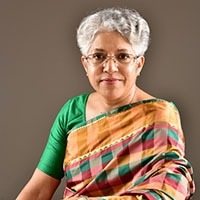By Madhura Swaminathan
Chairperson, M.S. Swaminathan Research Foundation & World Food Prize Foundation Council of Advisors
In all parts of the world, women play an important role in the food system: in crop production, in animal rearing, in post-harvest agro-processing, in food marketing, and in cooking, child feeding and waste disposal. In the policy sphere and in data and research, however, they remain unseen. On this International Women’s Day, let us begin by recognizing the foundational role of women in agriculture, food and nutrition security.
As scientists and researchers, we need to consciously make women visible in our work, from problem-setting to policy formulation. To illustrate, when agronomists, engineers and extension workers recommend new farming practices, is the impact on women as farmers and workers part of their calculation? Do they assess, for example, women’s demand for mechanization? Which are the activities that women find drudgerous and that require new tools and technologies? And what are the effects of spread of tractors or other machines on women’s employment and incomes? These are examples of questions that need to be a central part of the agenda of all those engaged in agricultural research and policy.

Closer to home, for over three months, there has been a massive farmer’s protest movement in India, opposing three pieces of new legislation affecting marketing of farm produce that threaten their income security. Women are very visible in this protest. This has come as a surprise to many observers of farming in India.
I make two suggestions for action.
First, researchers and research organisations must begin to count women’s contribution to the food system, be it paid or unpaid. New tools need to be developed to measure these contributions, and well-established tools such as time-use surveys (that measure all activity in a given time, say 24 hours) need to be implemented regularly.
In a recent study of villages in India we found that if actual hours of work are carefully counted, almost all women would be counted as workers. The official labour force surveys for rural India show a very low work participation by contrast. Further, the actual hours worked a day when economic and care work was combined was no less than 60 hours a week and went up to 80 and more hours a week (Women and Work in Rural India edited by Madhura Swaminathan, Shruti Nagbhushan and V. K. Ramachandran, Tulika books, New Delhi, 2020).
Working from home (the field or the farm house) can no longer be ignored. And, perhaps, the experience of the pandemic can accelerate the move towards understanding women’s contribution from home-based work.
Secondly, land is the basis of agriculture and allied activities, and in most countries, land is legally owned by men. It is time for us to demand, at the very least, that ownership of land and other productive assets be held jointly in the name of women and men (typically a farm couple). Many States of India, particularly those with successful land reform such as Kerala and West Bengal, introduced this concept of “joint deed,” that is, where land was redistributed by the state to erstwhile landless households, the ownership deed was in the name of husband and wife. The concept of joint ownership can give women legal recognition of their role in agriculture.
Originally published on the World Food Prize website and has been reprinted with permission.
Your donation to CAST helps support the CAST mission of communicating science to meet the challenge of producing enough food, fiber and fuel for a growing population. Every gift, no matter the size, is appreciated.